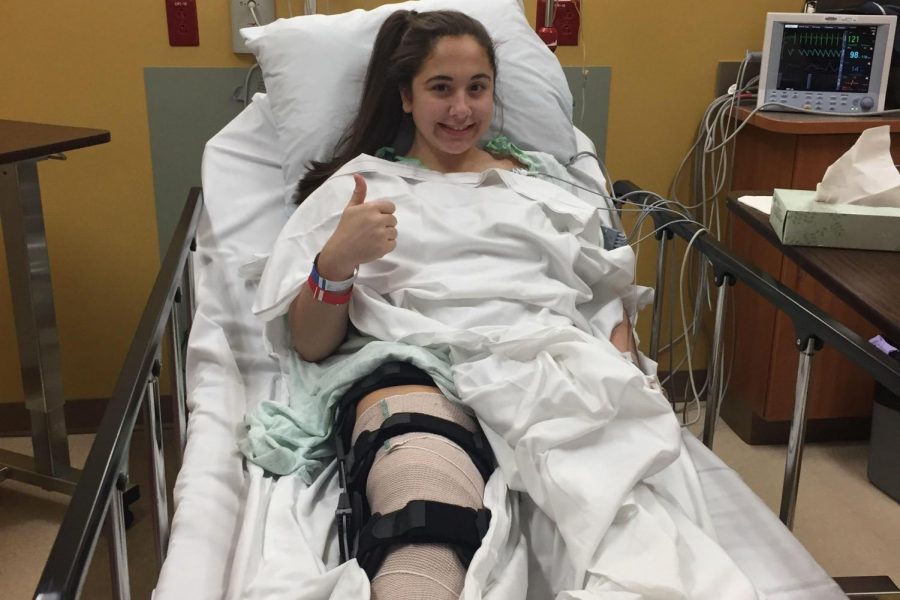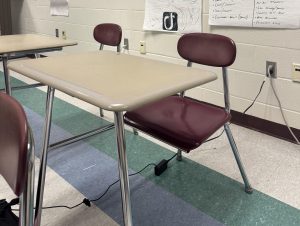Snap, crackle pop
Pictured is me, Sofia Barassi, sitting in my hospital bed after my ACL surgery in November of 2017. I tore my ACL playing field hockey and thought that it was the end of my career. Now I’m recovered and ready to play my favorite sport again. It was a very scary experience, but Arnold couldn’t have stated it better, “I’ve learned you need to go hard at what you love to do, because it can be taken from you at any time.”
September 11, 2018
One wrong step, one wrong pivot, one wrong jolt, and your athletic career can be jeopardized forever. When you tear your anterior cruciate ligament (ACL), just as I did, many things in your life stop instantly. You have to adjust to an entirely new lifestyle of not walking, not doing what you love, and not being the same as you used to be. These injuries may lower academic performance, decrease scholarship opportunities, sit you out for multiple seasons, and significantly increase the possibility of future knee problems such as joint pain and arthritis. The excruciating pain you feel immediately after the wrong step is just the beginning of the long journey ahead.
The ACL keeps the femur and tibia connected. Once torn, the ability to walk, change direction, and make any sudden movements is limited if not entirely impossible for many months. The most common way that someone tears their ACL is when changing directions suddenly while unexpectedly stopping, landing, or keeping one’s leg straight. A “pop” sound is commonly heard and felt, along with swelling and an inability to straighten one’s leg while walking. These effects don’t always subside unless surgery is performed.
The recovery time for an ACL tear averages about 10-12 months, yet that time frame has begun to expand in recent years due to people returning too early to their sports and activities, and retearing their previously operated-on ligament. Each person’s recovery time is different, but nonetheless, it is one long and grueling process for athletes. Some patients do not recover the proper way, causing them to re-tear their ACL and have to start from the beginning. Our athletic trainer at HB, Mike Thompson, has torn his ACL in the past and is very informed about the injury because he has worked with so many of these cases. Premature return to play is a big concern for athletes and Thompson believes that, “A lot of times places don’t specialize in ACL recovery so, they believe using plyometrics and agility routines is proper which isn’t the case.”
In the United States alone, there are about 200,000 ACL tears per year. Why is this? Why is there no prevention? Many doctors, physical therapists, and medical specialists have researched to discover a solution. The main cause of it, as discovered so far, is weak hip and core muscles. Building up these essential muscles is one way to lessen the chances of an ACL tear. When asked what his thoughts about the prevention of these injuries are, Thompson stated, “Education on deceleration and landing positions is how to prevent it.” He added that “increasing athletes glute and hamstring strength will prevent further injury.” With all of this advice in mind, there really is no definite way to prevent these career altering injuries so far. As many physical therapists go to ACL prevention workshops just as Heather Comstock, Karin Biskovich, and Laura Jackson from Apple Therapy in Amherst, NH went to. They were just a few of the eager, trained therapists who want to become more educated about how to prevent these injuries from occurring so often.
These injuries can occur from just about any physical activity, but it is mostly seen in teenage to young adult athletes. A member of the Football Team, JT Arnold ‘19, tore his ACL in fall of 2017 while playing a game against Souhegan High School. “The hardest part was not being able to play in the next game, and having to wait to do simple things like running again,” said Arnold. This type of injury can cause a lot of stress and put doubt in people’s minds about ever playing again just as it did with me. Although, having a positive outlook, like Arnold, will certainly help with the recovery. “The injury hasn’t changed me. I know over time I’ll be back to the point I was before the injury,” said Arnold.
Each person is different in their experience with an ACL injury, but one thing for all people to know is that hard work and dedication will quicken your recovery. Keeping a positive outlook and never giving up will do a person wonders. As the wise Miley Cyrus once said, “If you believe in yourself, anything is possible.”














